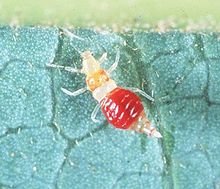Franklinothrips
| Franklinothrips | |
|---|---|

| |
| AdultF. vespiformis. | |
| Scientific classification | |
| Domain: | Eukaryota |
| Kingdom: | Animalia |
| Phylum: | Arthropoda |
| Class: | Insecta |
| Order: | Thysanoptera |
| Family: | Aeolothripidae |
| Genus: | Franklinothrips Back, 1912 |
| Type species | |
| Aeolothrips vespiformis Crawford, 1909
| |
| Synonyms | |
|
MitothripsTrybom, 1912 | |
Franklinothripsis a genus ofthripswithpantropicaldistribution.
Name
[edit]The genus name is derived from the surname of entomologist H. J. Franklin, who described thrips taxa in the early 1900s. The thrips genusFrankliniellais also named after him. Franklin worked at the entomology department of theUniversity of Massachusetts Amherstin the 1930s.
Reproduction
[edit]
Most species are apparently bisexual (have both males and females) and occur only in small areas. An exception isF. vespiformis,which is unisexual (mostly females) and occurs in many tropical countries. Only few males were produced during rearing programmes involvingF. vespiformis.
Mimicry
[edit]The fast-running females are easily misidentified as ants orbethylidwasps (superfamilyChrysidoidea), as they closely mimic ants in behavior and body form. Males are less ant-like in appearance, being smaller, with longer antennae and a less constricted waist.[1]
Feeding behavior
[edit]F. orizabensisis known to be unable to survive solely on plant food. It is used as a control agent against thrips onavocadotrees. Together withF. vespiformisit has been marketed in Europe as a control agent against thrips ingreenhouses.F. vespiformisalso feeds onmites,nymphsof awhiteflyspecies and the larvae of anagromyzidfly.F. megalopshas been used for thrips control in "internal landscapes".
Taxonomy
[edit]- F. atlasHood, 1957— Congo, Rwanda.
- F. bassetiMound & Marullo, 1998— Rainforest trees near Brisbane, Queensland, Australia.
- F. brunneicornisMound & Renaud, 2005— New Caledonia.
- F. caballeroiJohansen, 1979— Mexico, Costa Rica.
- F. fulgidusHood, 1949— Southern Brazil.
- F. lineatusHood, 1949— Southern Brazil, Costa Rica.
- F. megalopsTrybom, 1912— Widespread in Africa, also Spain, Israel, southern India.
- F. occidentalisPergande,— Western Flower Thrips
- F. orizabensisJohansen, 1974— Mexico, southern California.
- F. rarosaeReyes, 1994— Philippines.
- F. strasseniMound & Reynaud, 2005— Nepal.
- F. suzukiiOkajima, 1979— Taiwan.
- F. taniMirab-balou & Chen, 2011— China.
- F. tenuicornisHood, 1915— Panama to southern Brazil.
- F. variegatusGirault, 1927— Australia.
- F. vespiformis(Crawford DL, 1909)— Central America, introduced into many tropical countries, including southern USA, Japan, New Caledonia, Australia.
The three neotropical speciesF. orizabensis,F. tenuicornisandF. vespiformisare closely related.
The speciesF. megalops,F. rarosaeandF. variegatusappear to part of aclineacross the Old World tropics from Africa to Australia, withF. rarosaebeing intermediate in appearance as well as distribution.
The only genus closely related toFranklinothripsisCorynothripoidesfrom Africa, and its only species,C. marginipennis,could even belong to the same genus.
F. caballeroiandF. suzukiiare possibly the same species, with one having been distributed through horticultural trade.
References
[edit]- ^Mound, L.A.; Reynaud, P. (2005)."Franklinothrips;a pantropical Thysanoptera genus of ant-mimicking obligate predators (Aeolothripidae) "(PDF).Zootaxa.864:1–16.doi:10.11646/zootaxa.864.1.1.
- Mirab-balou, M.; Shi, M. & Chen, X.-X. (2011)."A new species ofFranklinothripsBack (Thysanoptera: Aeolothripidae) from Yunnan, China "(PDF).Zootaxa.2926:61–64.doi:10.11646/zootaxa.2926.1.4.
- Mound, Laurence. A.; Reynaud, Philippe (2005)."Franklinothrips;a pantropical Thysanoptera genus of ant-mimicking obligate predators (Aeolothripidae) "(PDF).Zootaxa.864:1–16.doi:10.11646/zootaxa.864.1.1.Includes key to species and color photographs.
- Thrips of the World Checklist:GenusFranklinothrips
